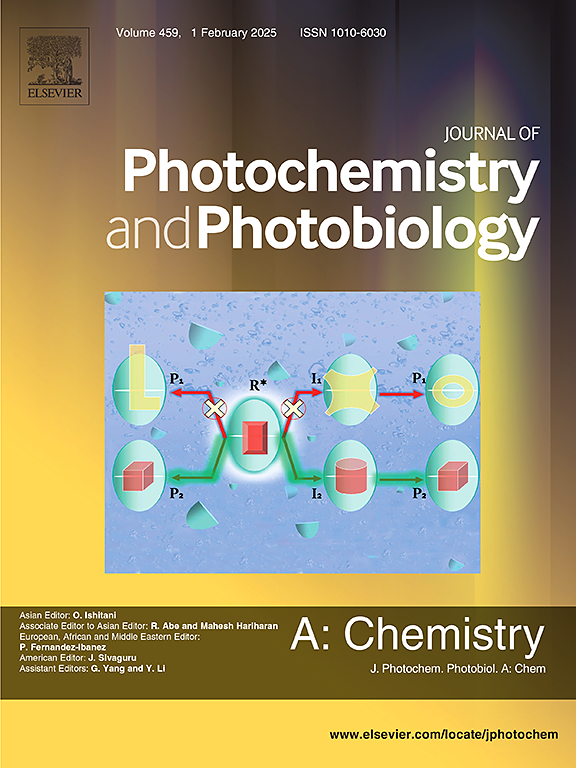Recognition-enrichment-in-situ degradation of p-chlorophenol by Fe-IL@UIO-66
IF 4.1
3区 化学
Q2 CHEMISTRY, PHYSICAL
Journal of Photochemistry and Photobiology A-chemistry
Pub Date : 2025-02-21
DOI:10.1016/j.jphotochem.2025.116347
引用次数: 0
Abstract
Persistent organic pollutants (POPs) represent a significant environmental and health risk due to their high toxicity, persistence, strong accumulation potential, and adverse effects on human health. 4-Chlorophenol (4-CP), a type of POP, has low catalytic efficiency at low concentrations and is easily interfered with by other pollutants, making its degradation challenging. A new “recognition-enrichment-in-situ degradation” strategy is introduced to selectively remove chlorophenols from contaminated aqueous environments. In this study, ionic liquids were incorporated into the UIO-66 framework as active sites for selective adsorption. 4-CP contains phenolic hydroxyl groups and exhibits high polarity. The dispersive interactions between 4-CP and ionic liquids, along with hydrogen-bonding interactions between the Tf2N anion and the hydroxyl groups of 4-CP, enhance the selective enrichment of 4-CP within the nanocavities of the metal–organic frameworks (MOFs). Fe3+ was then introduced, enabling in-situ degradation of 4-CP through photo-induced generation of free radicals and cavities from H2O2 catalyzed by Fe-IL@UIO-66. The results indicated that the adsorption capacity of IL@UIO-66 for 4-CP reached 53 %, significantly higher than that for five other organic pollutants. The adsorption capacity of IL@UIO-66 for 4-CP reached 509.5 mg g−1, 49.9 % greater than that of the original UIO-66. The degradation efficiency of 4-CP by Fe-IL@UIO-66 increased from 61 % to 81 %, and after four cycles, the material retained a catalytic activity with a degradation efficiency of 64.2 %. This study provides valuable insights into the recognition-enrichment-in-situ catalytic strategy for treating low-concentration, highly toxic wastewater.

Fe-IL@UIO-66对氯酚的识别富集原位降解
持久性有机污染物由于其高毒性、持久性、强大的积累潜力和对人类健康的不利影响,构成了重大的环境和健康风险。4-氯苯酚(4-CP)是POP的一种,在低浓度下催化效率低,且容易受到其他污染物的干扰,使其降解困难。介绍了一种新的“识别-富集-原位降解”策略,以选择性地去除污染水环境中的氯酚。在本研究中,离子液体被纳入到UIO-66框架中作为选择性吸附的活性位点。4-CP含有酚羟基,具有高极性。4-CP与离子液体之间的色散相互作用,以及Tf2N阴离子与4-CP羟基之间的氢键相互作用,增强了4-CP在金属有机框架(mof)纳米腔内的选择性富集。然后引入Fe3+,通过Fe-IL@UIO-66催化H2O2产生光诱导自由基和空腔,实现4-CP的原位降解。结果表明,IL@UIO-66对4-CP的吸附量达到53%,显著高于其他5种有机污染物。IL@UIO-66对4-CP的吸附量达到509.5 mg g−1,比原UIO-66的吸附量提高49.9%。Fe-IL@UIO-66对4-CP的降解效率从61%提高到81%,经过4次循环后,材料仍保持64.2%的降解效率。该研究为处理低浓度、高毒性废水的原位识别富集催化策略提供了有价值的见解。
本文章由计算机程序翻译,如有差异,请以英文原文为准。
求助全文
约1分钟内获得全文
求助全文
来源期刊
CiteScore
7.90
自引率
7.00%
发文量
580
审稿时长
48 days
期刊介绍:
JPPA publishes the results of fundamental studies on all aspects of chemical phenomena induced by interactions between light and molecules/matter of all kinds.
All systems capable of being described at the molecular or integrated multimolecular level are appropriate for the journal. This includes all molecular chemical species as well as biomolecular, supramolecular, polymer and other macromolecular systems, as well as solid state photochemistry. In addition, the journal publishes studies of semiconductor and other photoactive organic and inorganic materials, photocatalysis (organic, inorganic, supramolecular and superconductor).
The scope includes condensed and gas phase photochemistry, as well as synchrotron radiation chemistry. A broad range of processes and techniques in photochemistry are covered such as light induced energy, electron and proton transfer; nonlinear photochemical behavior; mechanistic investigation of photochemical reactions and identification of the products of photochemical reactions; quantum yield determinations and measurements of rate constants for primary and secondary photochemical processes; steady-state and time-resolved emission, ultrafast spectroscopic methods, single molecule spectroscopy, time resolved X-ray diffraction, luminescence microscopy, and scattering spectroscopy applied to photochemistry. Papers in emerging and applied areas such as luminescent sensors, electroluminescence, solar energy conversion, atmospheric photochemistry, environmental remediation, and related photocatalytic chemistry are also welcome.

 求助内容:
求助内容: 应助结果提醒方式:
应助结果提醒方式:


